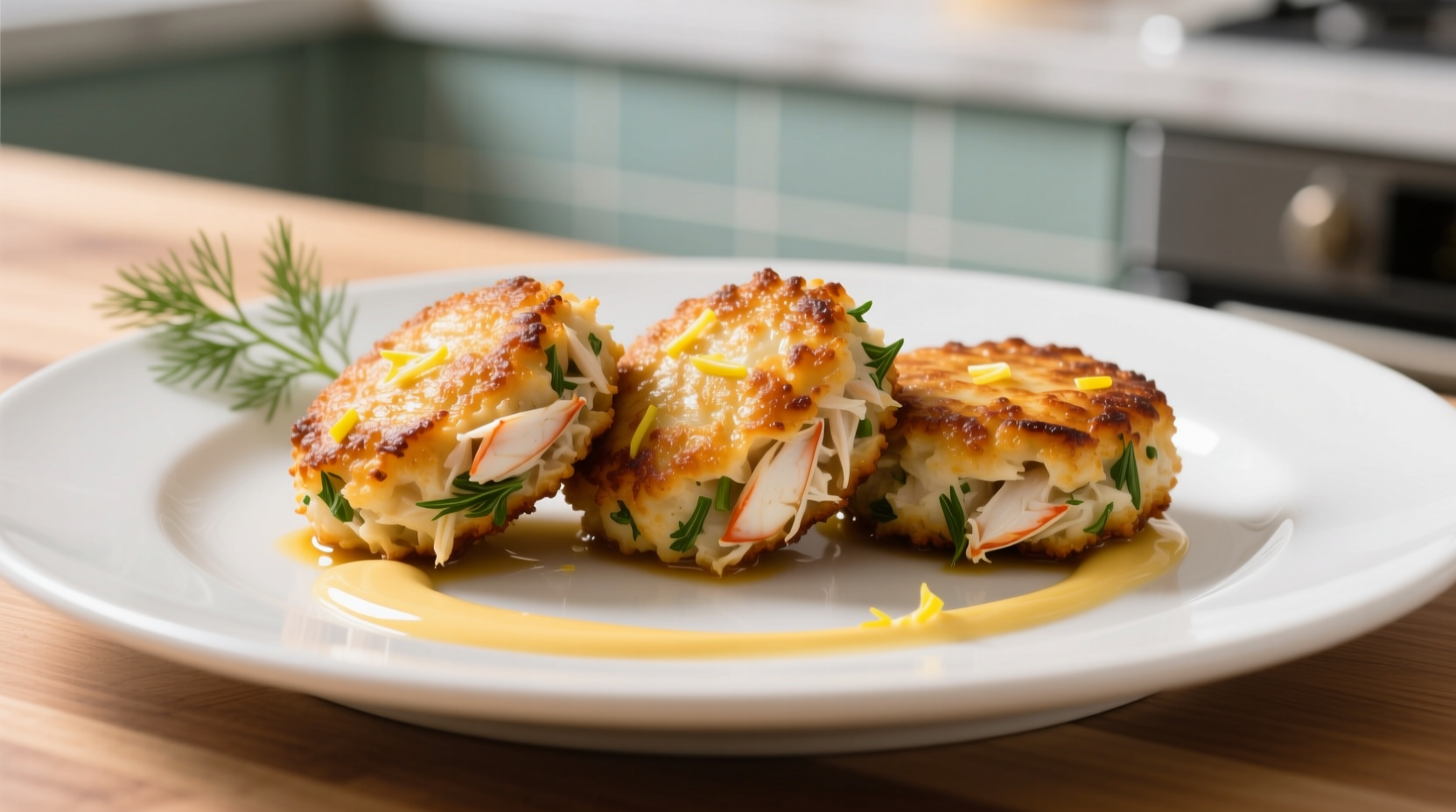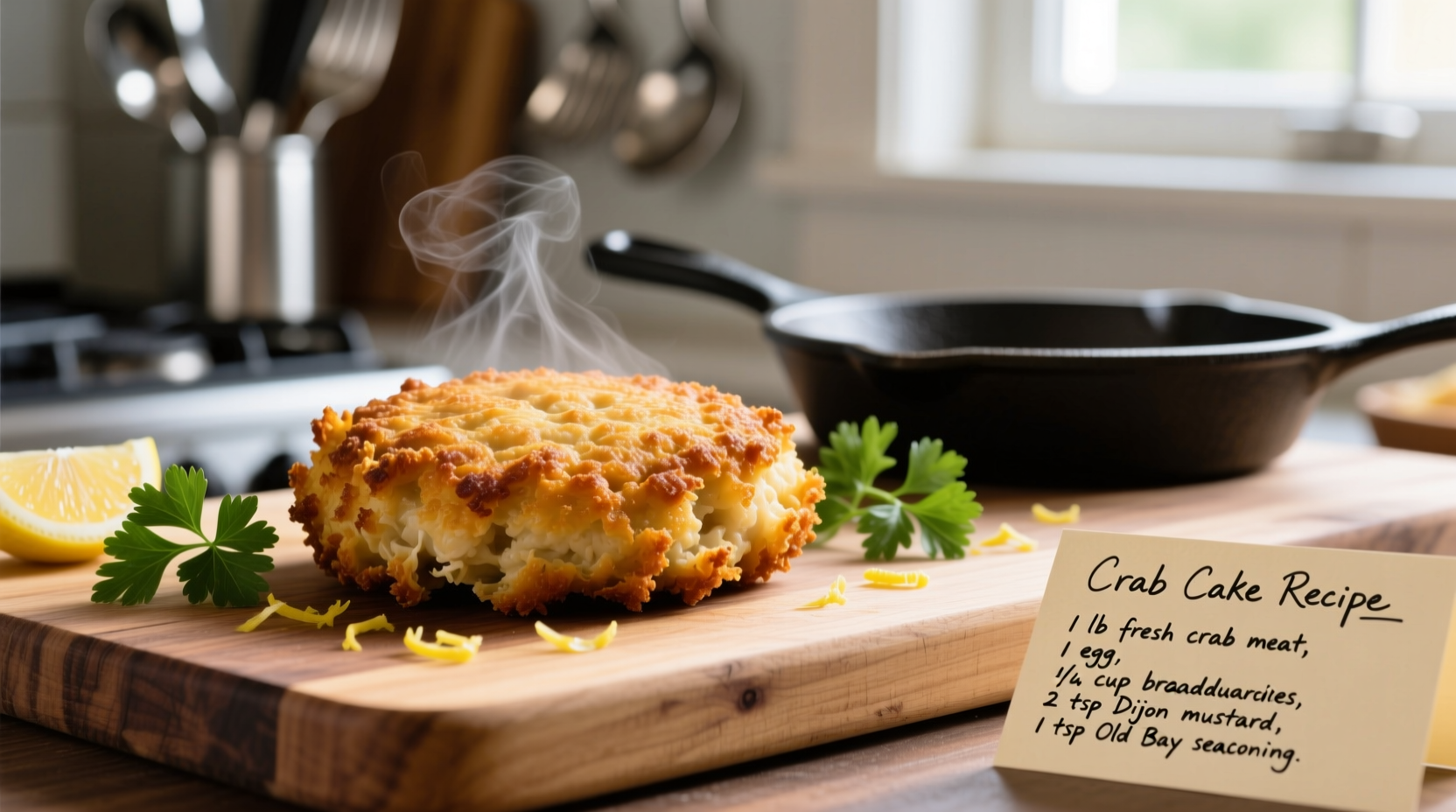Perfect crab cakes require fresh lump crab meat, minimal binding ingredients, and gentle handling. Cook them in a hot skillet with oil and butter for 4-5 minutes per side until golden brown and heated through to 145°F (63°C). Avoid overmixing to prevent dense, falling-apart cakes. This guide provides step-by-step instructions with professional chef techniques for restaurant-quality crab cakes at home.
Craving restaurant-quality crab cakes but worried about them falling apart or lacking flavor? You're not alone. Many home cooks struggle with crab cakes because they overcomplicate the recipe or use improper techniques. The truth is, perfect crab cakes rely on three fundamentals: quality crab meat, minimal handling, and precise cooking temperature. Forget everything you thought you knew about crab cakes needing excessive breadcrumbs or binders - the best versions showcase the delicate crab flavor with just enough structure to hold together.
Essential Ingredients for Perfect Crab Cakes
Choosing the right ingredients makes or breaks your crab cakes. Unlike many recipes that mask the crab flavor with excessive fillers, professional chefs prioritize showcasing the star ingredient.
| Crab Meat Type | Flavor Profile | Best For | Price Range (per pound) |
|---|---|---|---|
| Lump crab meat | Sweet, delicate, premium | Main crab cake ingredient | $25-$35 |
| Claw meat | Stronger, meatier flavor | Filler in budget recipes | $15-$22 |
| Special grade | Balanced flavor and texture | Best value option | $18-$28 |
| Canned crab | Less sweet, more processed | Emergency substitute only | $8-$12 |
According to the U.S. Food and Drug Administration's seafood guidelines, fresh crab meat should be refrigerated at 40°F or below and used within 2 days of purchase for optimal safety and flavor. When selecting crab meat, look for moist but not watery packages with no discoloration.
Equipment Checklist
Having the right tools ensures consistent results:
- Non-stick or cast iron skillet (10-12 inches)
- Cookie scoop or measuring cup for portioning
- Flat metal spatula for flipping
- Instant-read thermometer
- Mixing bowl (chilled)
Step-by-Step Crab Cake Preparation
Preparation Phase (15 minutes)
Gently combine in a chilled bowl:
- 1 pound fresh lump crab meat (picked over for shells)
- 1 large egg yolk (not whole egg)
- 1 tablespoon mayonnaise
- 1 teaspoon Dijon mustard
- 1 tablespoon finely minced shallot
- 1 tablespoon fresh parsley
- 1 teaspoon Old Bay seasoning (or homemade blend)
- 1-2 tablespoons panko breadcrumbs (only if needed)
Professional chefs from the Culinary Institute of America emphasize that overmixing is the #1 cause of failed crab cakes. Fold ingredients together just until combined - visible lumps of crab meat are desirable.
Chilling Process (Minimum 1 hour)
Refrigerate formed cakes on a parchment-lined tray. This critical step allows the ingredients to bind properly. Never skip chilling - it prevents crumbling during cooking. For best results, prepare crab cakes the night before and cook them the next day.
Cooking Technique (The Professional Method)

Cooking crab cakes properly requires precise temperature control:
- Heat 2 tablespoons oil and 1 tablespoon butter in skillet over medium heat (350°F)
- Place chilled cakes in hot skillet, leaving space between them
- Cook 4-5 minutes until golden brown on first side
- Carefully flip using thin metal spatula
- Cook additional 4-5 minutes until internal temperature reaches 145°F
- Drain on wire rack (not paper towels) to maintain crispness
The National Center for Home Food Preservation confirms that seafood should reach an internal temperature of 145°F for safe consumption. Use an instant-read thermometer to verify doneness without cutting into the cakes.
Avoiding Common Crab Cake Mistakes
Even experienced cooks make these critical errors:
Overbinding
Using too many breadcrumbs or binders masks the delicate crab flavor. If your mixture holds together when gently pressed, you don't need additional binders. Most professional recipes use less than 2 tablespoons of binding ingredients per pound of crab.
Incorrect Oil Temperature
Oil that's too cool causes cakes to absorb grease; oil that's too hot burns the exterior before the interior heats through. Test with a breadcrumb - it should sizzle immediately but not smoke.
Disturbing Too Soon
Resist the urge to move cakes immediately after placing in the skillet. Let them develop a crust (about 2 minutes) before attempting to flip. Properly heated oil creates instant sear that prevents sticking.
Serving and Storage Guidelines
Serve immediately with lemon wedges and remoulade sauce. For optimal texture, never hold cooked crab cakes in a warm oven for more than 10 minutes.
Storage recommendations:
- Refrigerate leftovers within 2 hours
- Store in airtight container with parchment between layers
- Consume within 2 days for best quality
- Reheat in 350°F oven for 8-10 minutes (not microwave)
Crab Cake Evolution Timeline
Crab cakes have evolved significantly from their origins:
- 1800s - First appeared in Maryland as simple crab and bread mixtures
- Early 1900s - Restaurants added mayonnaise and spices for binding and flavor
- 1940s-1960s - Became popularized as a regional specialty with standardized recipes
- 1980s-1990s - Gourmet versions emerged with premium ingredients and creative presentations
- 2000s-Present - Focus shifted to minimal ingredient approaches highlighting quality crab
Modern culinary trends emphasize showcasing the crab itself rather than masking it with excessive fillers - a return to the dish's simple origins but with refined techniques.
Context-Specific Cooking Methods
The best cooking method depends on your specific situation:
- Weeknight dinner - Pan-frying provides fastest results with best texture
- Large gatherings - Bake at 375°F for 15-18 minutes (flip halfway)
- Dietary restrictions - Air fry at 360°F for 8-10 minutes with light oil spray
- Outdoor cooking - Grill over medium heat for 4-5 minutes per side on oiled grates
Remember that baking produces more uniform cooking but lacks the signature crispy exterior that defines perfect crab cakes. For special occasions, pan-frying remains the professional standard.
Why do my crab cakes keep falling apart?
Crab cakes fall apart primarily due to overmixing or excessive moisture. Use only enough binder to hold ingredients together (often just an egg yolk and minimal breadcrumbs), handle gently, and always chill for at least 1 hour before cooking. Fresh crab meat with lower moisture content works best - avoid canned varieties which often contain excess liquid.
Can I make crab cakes ahead of time?
Yes, preparing crab cakes 24 hours in advance actually improves texture. Form the cakes, place on a parchment-lined tray, cover with plastic wrap, and refrigerate. The chilling time allows flavors to meld and ingredients to bind properly. Cook directly from cold - don't bring to room temperature before cooking.
What's the best oil for frying crab cakes?
Use a combination of neutral oil with high smoke point (like canola or grapeseed) and butter. Heat 2 tablespoons oil and 1 tablespoon butter to 350°F. The oil prevents burning while the butter adds flavor. Never use olive oil alone as its low smoke point causes burning at the required temperature.
How can I tell when crab cakes are done cooking?
Crab cakes are done when they reach an internal temperature of 145°F and have a deep golden-brown crust on both sides. Visual cues include the cakes releasing easily from the pan when properly seared and feeling slightly firm to gentle pressure. Never cut into them to check - use an instant-read thermometer inserted from the side.
What are traditional sides for crab cakes?
Classic pairings include remoulade sauce, lemon wedges, and simple green salad. In Maryland, crab cakes are traditionally served with coleslaw and hushpuppies. Modern presentations often include citrus-dill aioli and roasted vegetable medleys. Avoid heavy starches that compete with the delicate crab flavor.











 浙公网安备
33010002000092号
浙公网安备
33010002000092号 浙B2-20120091-4
浙B2-20120091-4